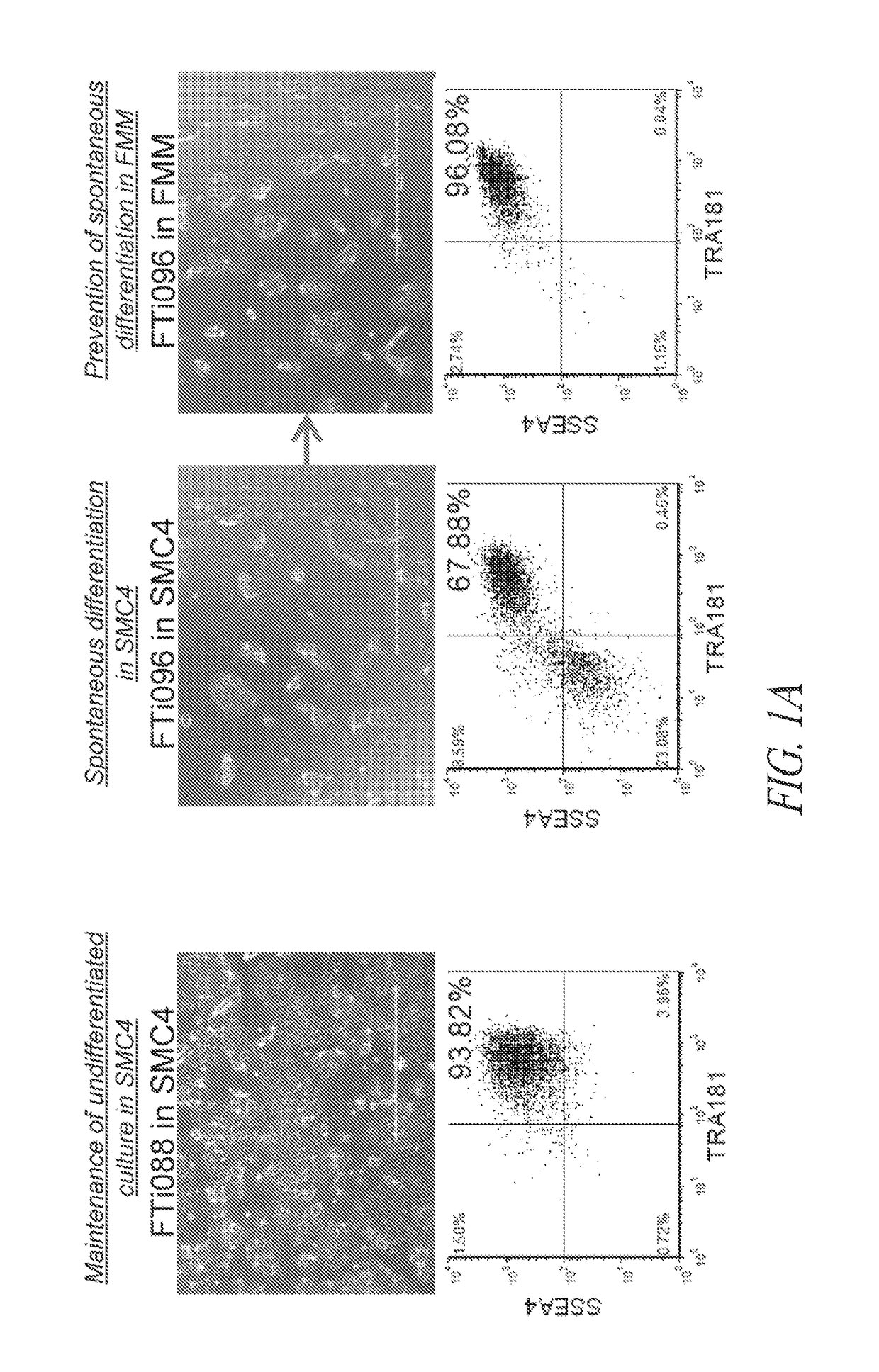Improved reprogramming methods and cell culture platforms
- Summary
- Abstract
- Description
- Claims
- Application Information
AI Technical Summary
Benefits of technology
Problems solved by technology
Method used
Image
Examples
example 1
Identification of a Medium Platform for Long-Term Maintenance and Expansion of iPSCs
Overview
[0406]The majority of lentiviral-derived hiPSC lines in SMC4-supplemented cultures maintain a homogeneous population of undifferentiated cells; however; silencing of the transgenic reprogramming factor in a subset of lines displayed various degrees of spontaneous differentiation in extended culture (FIGS. 1A and B). Therefore, various cell culture components were assessed in order to identify conditions for the maintenance of pluripotency during continuous FF culture and single-cell enzymatic passage irrespective of residual transgene expression. A multi-stage culture system that targets unique pathways at different stages of the reprogramming and maintenance process was identified as an efficient and robust approach to hiPSC generation.
Results
[0407]Inhibition of TGFβ pathway during long-term maintenance was identified as a significant factor in the spontaneous differentiation of hiPSC lines ...
example 2
Platform for Manufacturing Transgene-Free hiPSCs in a Single Cell Passage and FF Format
Overview
[0411]The efficiency of non-integrative reprogramming methods using episomal vector systems is extremely low (<0.001%), especially in FF environments (Narsinh et al., 2011; O'Doherty et al., 2013). Episomal-induction was tested in a multi-stage culture system including two media: Fate Reprogramming Medium (FRM) containing SMC4 and medium additives shown to improve reprogramming and FMM (FIG. 2A and Table 1).
Results
[0412]An episomal expression system consisting of gene combination OCT4 / SOX2 / NANOG / KLF4 / LIN28 / MYC / SV40LT (OSNKLMT) was used to transfect various fibroblast cells. Twenty-four hours after induction of episomal expression, the reprogramming culture is transitioned to FRM to enhance reprogramming kinetics. Early colony formation was observed within the first week and by day 10, a large population of SSEA4 / TRA1-81 positive cells was detected (>1%) (FIGS. 8A and 8B). On Day 14, the re...
example 3
Long-Term Passage and Expansion of Transgene-Free hiPSC Lines in FMM
Overview
[0415]The long-term passage and expansion of hiPSC using the multi-stage media platform of FRM and FMM was studied using hiPSC clones from Example 2, expanded as single cells in FF culture (FIGS. 3A and 3B).
Results
[0416]hiPSC lines reprogrammed according to Example 2 lost episomal DNA by passage 4-7 and thus, pluripotent independent of the transgene-based reprogramming factors (FIG. 3C). The hiPSC lines maintained a homogeneous population of undifferentiated cells positive for SSEA4, TRA1-81, OCT4 and NANOG. Moreover, these lines maintained pluripotent characteristics (FIG. 3F) in the absence of any cleanup strategies that are commonly utilized in pluripotent culture (FIGS. 3D and 3E). Similar expansion of uniform hiPSC cultures were observed when Matrigel was replaced with the defined surface coating Vitronectin during routine single cell passaged culture (FIGS. 10E-10G).
[0417]Genomic abnormalities are ofte...
PUM
| Property | Measurement | Unit |
|---|---|---|
| Fraction | aaaaa | aaaaa |
| Fraction | aaaaa | aaaaa |
| Fraction | aaaaa | aaaaa |
Abstract
Description
Claims
Application Information
 Login to View More
Login to View More - R&D
- Intellectual Property
- Life Sciences
- Materials
- Tech Scout
- Unparalleled Data Quality
- Higher Quality Content
- 60% Fewer Hallucinations
Browse by: Latest US Patents, China's latest patents, Technical Efficacy Thesaurus, Application Domain, Technology Topic, Popular Technical Reports.
© 2025 PatSnap. All rights reserved.Legal|Privacy policy|Modern Slavery Act Transparency Statement|Sitemap|About US| Contact US: help@patsnap.com



